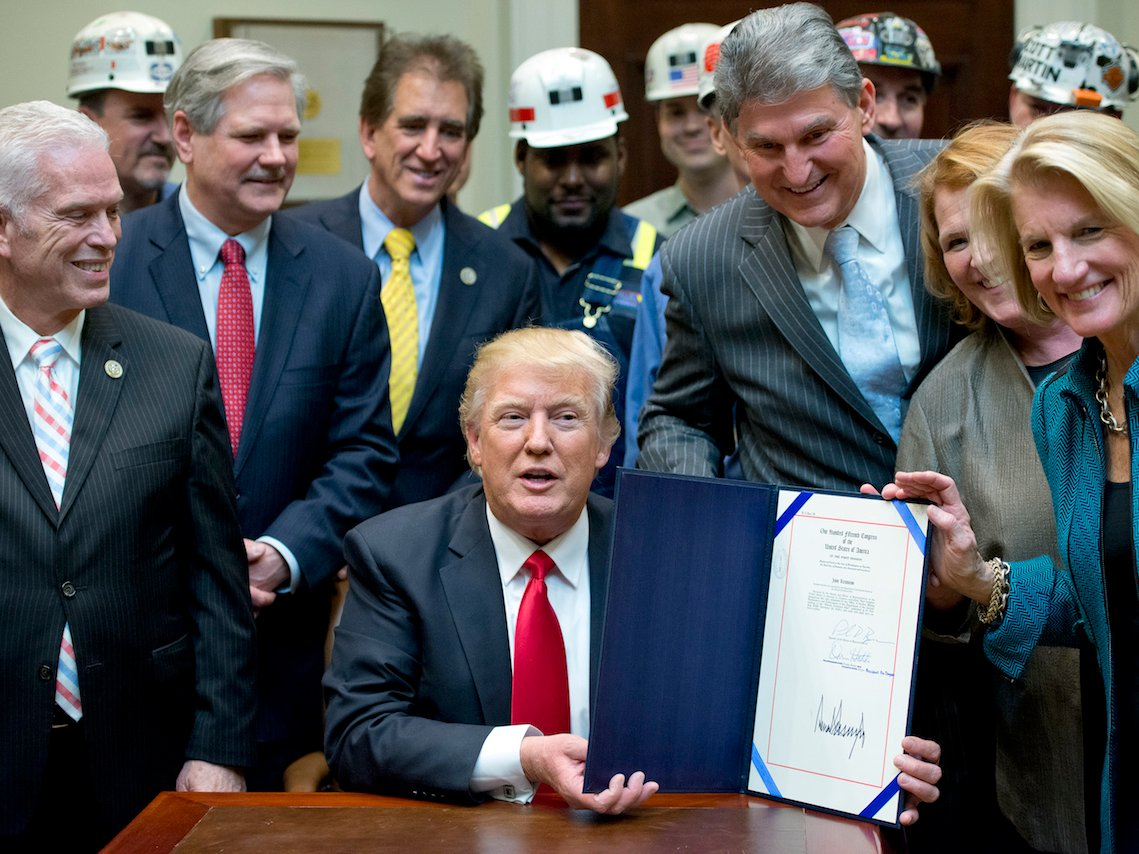
Sen Joe Manchin grins as Donald Trump signs legislation rescinding the
Stream Protection Rule in February 2017.
Save EPA, a
volunteer organization of former Environmental Policy Agency staffers,
has released a guide for
activists who wish to
counter attempts by the Trump administration to roll back public
protections issued by any federal agency. The guide is inspired by the
Indivisible project, which began as a guide for activist engagement with
Congress by former Hill staffers.
Trump has made systematic deregulation, a longtime priority of the Koch
brothers and other corporate-right leaders, a top priority. A January
executive
order
of questionable Constitutional legitimacy called for the elimination of
two federal regulations whenever a new regulation is issued.
The first draft of “A Practical Guide For Resisting The Trump
De-Regulatory Agenda”
explains:
Fortunately, no president can roll back regulations by fiat. The Trump
Administration must go through the same process that’s used for making
regulations, and that process gives everyone the opportunity to
participate. Regulated businesses are sure to participate, since they
are directly affected and may save money if regulations are delayed,
watered down or repealed. Public interest groups are likely to
participate, too, but they can’t be expected to save regulations all
on their own. As members of the public that the regulations are
designed to protect, we need to be loud and clear that the regulations
are important to us. We can’t afford to be silent while President
Trump tries to take away our protections.
The guide includes a comprehensive guide to the public comment process,
recommendations for how to draft effective comments, and additional tips
for influencing regulatory decisions. The guide also recommends Columbia
Law School’s Climate Deregulation
Tracker.
The guide can be downloaded
here.
An accompanying press release
offers three recommended actions to take for one current and two
upcoming comment periods:
Proposed 2-year stay and reconsideration of methane emissions
standards for oil and gas sector – The public comment period is
ongoing; comments must be received on or before 11:59 pm August 9. To
comment, search for Docket ID No.
EPA-HQ-OAR-2010-0505 on the federal
eRulemaking portal. The proposal was
signed June 16. EPA web
link
Waters of the U.S. rule proposed rescission – A
30-day comment period will begin soon when the rule, signed June
27, 2017, is published in the Federal Register. To comment, search for
Docket ID No. EPA-HQ-OW-2017-0203, on the
federal eRulemaking portal.
EPA web link
Withdrawal of proposed Pebble Mine determination –
EPA is proposing to withdraw a July 2014 Clean
Water Act Section 404© Proposed Determination that would have imposed
restrictions on the discharge of dredged or fill material from the
potential “Pebble Mine” in Alaska’s Bristol Bay watershed.
A 90-day comment period will begin soon when
the withdrawal notice is published in the Federal Register. Comments can
be emailed to
[email protected]
(reference docket number EPA-R10-OW-2017-0369
in the email subject line). EPA
link
 Today, the White House announced the
Today, the White House announced the
 An email sent by
An email sent by 
 Originally published at The Jacobin.
Originally published at The Jacobin. Laurence Tribe, the Harvard law professor who
argued the losing side of Bush v. Gore, is now defending the coal
industry against the Environmental Protection Agency’s planned rules for
greenhouse pollution from power plants. In a
Laurence Tribe, the Harvard law professor who
argued the losing side of Bush v. Gore, is now defending the coal
industry against the Environmental Protection Agency’s planned rules for
greenhouse pollution from power plants. In a